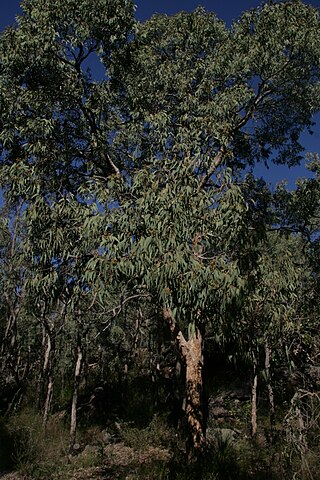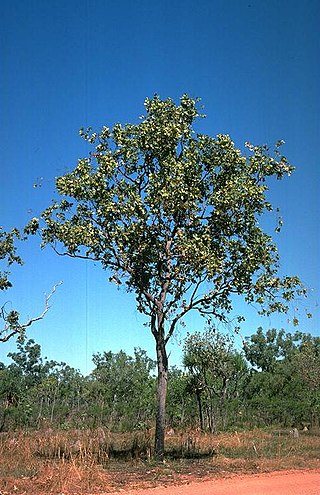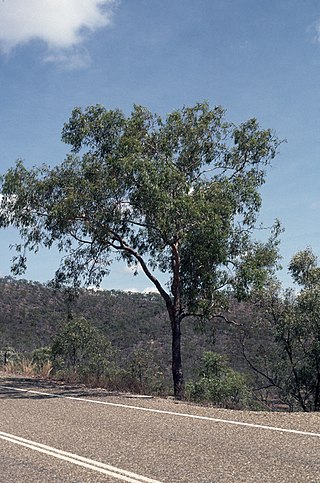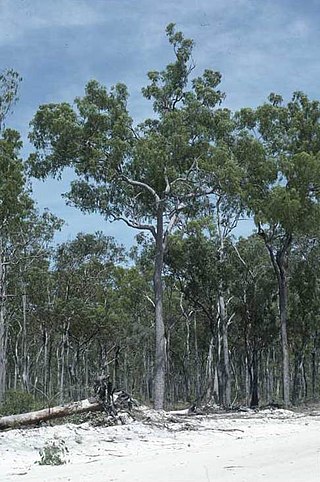
Corymbia eximia, commonly known as yellow bloodwood, is a bloodwood native to New South Wales. It occurs around the Sydney Basin often in high rainfall areas on shallow sandstone soils on plateaux or escarpments, in fire prone areas. Growing as a gnarled tree to 20 m (66 ft), it is recognisable by its distinctive yellow-brown tessellated bark. The greyish green leaves are thick and veiny, and lanceolate spear- or sickle-shaped. The cream flowerheads grow in panicles in groups of seven and appear in spring. Known for many years as Eucalyptus eximia, the yellow bloodwood was transferred into the new genus Corymbia in 1995 when it was erected by Ken Hill and Lawrie Johnson. It is still seen under the earlier name in some works.

Corymbia zygophylla, commonly known as the Broome bloodwood, is a species of small tree or a mallee that is endemic to Western Australia. It has rough, tessellated to fibrous bark on the trunk and branches, a crown of juvenile heart-shaped to lance-shaped, stem-clasping leaves, flower buds in groups of three or seven, white flowers and urn-shaped to shortened spherical fruit.

Eucalyptus pruinosa, commonly known as silver box, silver leaf box, apple box or smoke tree, is a species of tree or a mallee that is endemic to northern Australia. The Jaminjung peoples know the tree as yarrirra or jarnbiny, the Jaru as wararn and the Wagiman as wararn. It has rough, fibrous to flaky bark on the trunk and branches, a crown composed of juvenile, glaucous, heart-shaped to broadly elliptical leaves arranged in opposite pairs, flower buds arranged in groups of seven on the ends of branches, creamy white to pale yellow flowers and cylindrical to conical fruit.

Corymbia aspera, commonly known as rough-leaved ghost gum, rough leaf range gum, desert bloodwood, Brittle Range gum in Western Australia, or snappy gum in the Northern Territory is a species of tree that is endemic to northern Australia. It has smooth white bark, sometimes with a short stocking of rough bark near the base, a crown of sessile juvenile, heart-shaped or egg-shaped leaves, flower buds in groups of seven, creamy white flowers and cup-shaped, barrel-shaped or cylindrical fruit.

Corymbia bleeseri, commonly known as glossy-leaved bloodwood or smooth-stemmed bloodwood, is a species of tree that is endemic to northern Australia. It has thin, rough bark on part or all of the trunk, smooth bark above, lance-shaped to curved adult leaves, flower buds in groups of seven, creamy white flowers and barrel-shaped fruit.

Corymbia clavigera, commonly known as apple gum or cabbage gum, is a species of tree that is endemic to a small area in the north-west Kimberley region of Western Australia. It has smooth, pale grey and white bark, lance-shaped or elliptical adult leaves, flower buds in groups of three or seven, white flowers and urn-shaped to barrel-shaped fruit.

Corymbia cliftoniana is a species of tree that is endemic to northern Australia. It has thick, rough, tessellated bark on the trunk and branches, narrow lance-shaped adult leaves, flower buds in groups of seven, creamy white flowers and shortened spherical fruit.

Corymbia collina, commonly known as silver-leaved bloodwood, is a species of tree that is endemic to Western Australia. It has thin patchy rough bark on some or all of the trunk, smooth white to pale grey bark above, lance-shaped to curved adult leaves, flower buds in groups of seven, creamy white flowers and barrel-shaped fruit.

Corymbia erythrophloia, commonly known as red bloodwood, variable-barked bloodwood, red-barked bloodwood or gum-topped bloodwood, is a species of tree that is endemic to Queensland. It has rough bark on the trunk and branches, egg-shaped or lance-shaped adult leaves, flower buds in groups of seven, creamy white flowers and urn-shaped to spherical fruit.

Corymbia ferruginea, commonly known as rusty bloodwood, is a species of tree that is endemic to northern Australia. It has rough, tessellated bark on the trunk and branches, a crown of sessile juvenile leaves, flower buds in groups of three or seven, pale creamy yellow flowers and urn-shaped fruit.

Corymbia foelscheana, commonly known as broad-leaved bloodwood, fan-leaved bloodwood or smooth-barked bloodwood, is a species of small tree that is endemic to northern Australia. It has thin, rough, tessellated bark on some or all of the trunk, smooth bark above, broadly egg-shaped to broadly lance- shaped adult leaves, flower buds usually in groups of seven, creamy white flowers and urn-shaped fruit.

Corymbia hylandii, commonly known as Hyland's bloodwood, is a species of small tree that is endemic to part of the Cape York Peninsula. It has rough, tessellated bark on the trunk and branches, lance-shaped adult leaves, flower buds in groups of seven, creamy white flowers and urn-shaped fruit.
Corymbia clandestina, commonly known as Drummond Range bloodwood, is a species of small tree that is endemic to Queensland. It has rough, tessellated bark on the trunk and branches, lance-shaped adult leaves, flower buds in groups of seven, white flowers and urn-shaped to barrel-shaped fruit.
Corymbia lamprophylla, commonly known as shiny-leaved bloodwood, is a species of tree that is endemic to central Queensland. It has rough, tessellated bark on the trunk and larger branches, lance-shaped adult leaves, flower buds in groups of seven, creamy white flowers and urn-shaped fruit.

Corymbia latifolia, commonly known as round-leaved bloodwood, round leaf bloodwood, wubam and other names in indigenous languages, is a species of tree that is endemic to northern Australia. It has thin, rough bark over part or all of the trunk, smooth bark above, triangular or broadly egg-shaped adult leaves, flower buds in groups of seven, creamy white flowers and urn-shaped fruit.
Corymbia lenziana, commonly known as narrow-leaved bloodwood, is a species of small tree that is endemic to Western Australia. It has rough, tessellated bark on the trunk and branches, narrow lance-shaped to linear leaves, flower buds in groups of seven, white flowers and shortened spherical fruit.

Corymbia nesophila, commonly known as Melville Island bloodwood, is a species of tree that is endemic to northern Australia. It has rough, tessellated bark on the trunk and branches, lance-shaped or curved adult leaves, flower buds in groups of seven, creamy white flowers and urn-shaped fruit.
Corymbia porrecta, commonly known as grey bloodwood, is a species of small tree that is endemic to the Northern Territory. It has rough, tessellated bark on the trunk and branches, broadly lance-shaped to egg-shaped adult leaves, flower buds usually in groups of seven, creamy white flowers and urn-shaped to barrel-shaped fruit.
Corymbia scabrida, commonly known as rough-leaved yellowjacket, is a species of small tree that is endemic to central Queensland. It has rough, tessellated bark on the trunk and branches, a crown of juvenile and intermediate leaves, flower buds in groups of seven, white flowers and barrel-shaped to urn-shaped or shortened spherical fruit.
Corymbia xanthope, commonly known as Glen Geddes bloodwood, is a species of tree that is endemic to a small area of Queensland. It has thick, rough bark on the trunk and branches with yellow bark visible underneath, lance-shaped to curved adult leaves, flower buds in groups of seven, creamy white flowers and urn-shaped fruit.

















